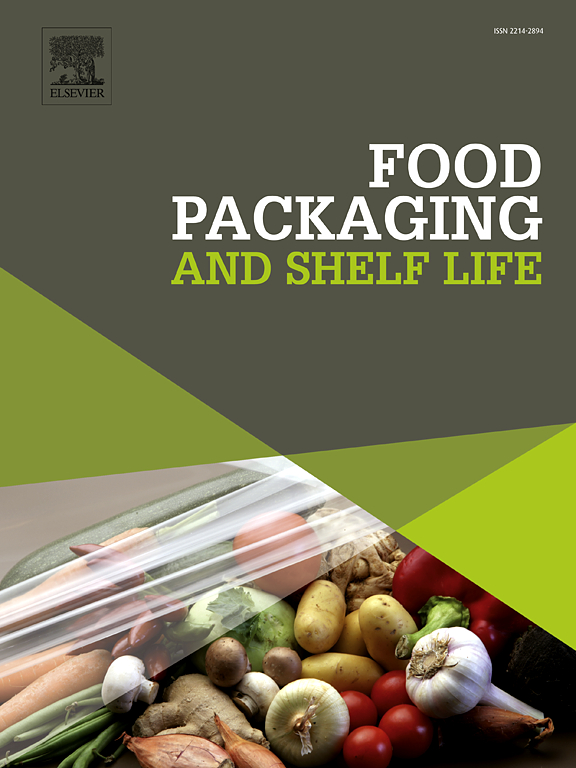Eco-friendly bionanocomposite based on a ternary blend reinforced with bacterial cellulose for application in packaging materials
IF 8.5
1区 农林科学
Q1 FOOD SCIENCE & TECHNOLOGY
引用次数: 0
Abstract
The search for sustainable materials is driven by the depletion of petrochemical resources and the environmental impact of plastics across various biomes. In this context, the present study develops eco-friendly films using bacterial cellulose derived from agro-industrial soursop (Annona muricata L.) wastes (BC-S) in ternary blends (TB) with poly(vinyl alcohol), polyvinylpyrrolidone, and poly(ethylene glycol). This blend showed a total concentration of 7,0 wt% with 8:1:1 proportion polymeric, respectively. The incorporation of BC-S (1.0, 3.0, and 5.0 %, v/v) resulted in: (i) the formation of homogeneous single-layer films; (ii) significant enhancement of mechanical properties, such as tensile strength (> 25.73 MPa), elongation at break (> 148.60 %), and increase in Young's modulus (> 3.0 GPa) by 73.9 %; (iii) excellent UV radiation protection, for UV-C (200–280 nm) an increase of 7.5 %; (iv) good water vapor barrier properties with a 54.5 % reduction; and (v) low transmittance and high transparency (an increase of 59.2 %) compared to the control treatment. The results demonstrate the potential of 5 % (v/v) BC-S derived from agro-industrial residues for sustainable applications as a reinforcement agent in bionanocomposites for food packaging. Therefore, it bolsters the concept of upcycling and eco-friendly packaging solutions.
基于细菌纤维素增强三元共混物的环保生物纳米复合材料在包装材料中的应用
石化资源的枯竭和塑料对各种生物群系的环境影响推动了对可持续材料的探索。在此背景下,本研究利用从农用工业番荔枝(Annona muricata L.)废物(BC-S)中提取的细菌纤维素与聚乙烯醇、聚乙烯吡罗烷酮和聚乙二醇三元共混物(TB)开发环保型薄膜。该共混物的总浓度为7 0 wt%,聚合物的比例为8:1:1。BC-S(1.0, 3.0和5.0 %,v/v)的加入导致:(i)形成均匀的单层薄膜;(ii)显著提高机械性能,如抗拉强度(>;25.73 MPa),断裂伸长率(>;148.60 %),杨氏模量增加(>;3.0 GPa) 73.9 %;(iii)优异的紫外线防护,对于UV- c(200-280 nm)增加7.5 %;(iv)良好的水蒸气阻隔性能,降低54.5 %;(5)低透光率和高透明度(比对照处理提高59.2 %)。结果表明,从农业工业残留物中提取的5 % (v/v) BC-S作为食品包装生物纳米复合材料的增强剂具有可持续应用的潜力。因此,它支持了升级回收和环保包装解决方案的概念。
本文章由计算机程序翻译,如有差异,请以英文原文为准。
求助全文
约1分钟内获得全文
求助全文
来源期刊

Food Packaging and Shelf Life
Agricultural and Biological Sciences-Food Science
CiteScore
14.00
自引率
8.80%
发文量
214
审稿时长
70 days
期刊介绍:
Food packaging is crucial for preserving food integrity throughout the distribution chain. It safeguards against contamination by physical, chemical, and biological agents, ensuring the safety and quality of processed foods. The evolution of novel food packaging, including modified atmosphere and active packaging, has extended shelf life, enhancing convenience for consumers. Shelf life, the duration a perishable item remains suitable for sale, use, or consumption, is intricately linked with food packaging, emphasizing its role in maintaining product quality and safety.
 求助内容:
求助内容: 应助结果提醒方式:
应助结果提醒方式:


